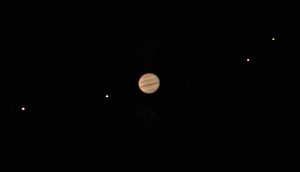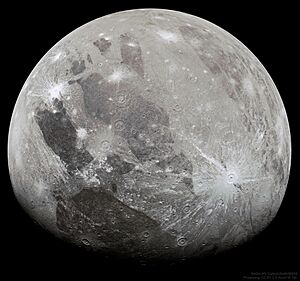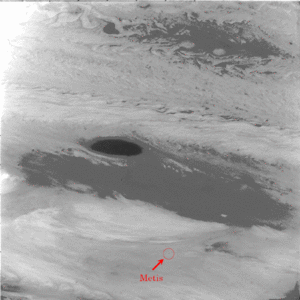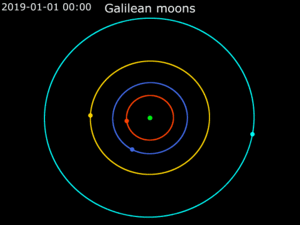Moons of Jupiter facts for kids
Jupiter has 95 confirmed moons as of early 2024. This number doesn't include tiny moonlets or hundreds of other possible small moons that were only briefly seen. All these moons together form Jupiter's Jovian system.
The most famous and largest moons are the four Galilean moons: Io, Europa, Ganymede, and Callisto. These were discovered in 1610 by Galileo Galilei and Simon Marius. They were the first objects ever found orbiting something other than Earth or the Sun. Later, starting in 1892, many smaller moons were found. They are named after lovers or daughters of the Roman god Jupiter (or his Greek equivalent Zeus). The Galilean moons are super massive. All the other 91 known moons and Jupiter's rings together make up only a tiny fraction (0.003%) of the total mass orbiting Jupiter.
Eight of Jupiter's moons are called regular satellites. They have nearly round orbits that are close to Jupiter's equator and move in the same direction as Jupiter spins (this is called prograde motion). The Galilean moons are so big that they are almost perfectly round. They would even be considered major planets if they orbited the Sun directly! The other four regular moons are much smaller and orbit closer to Jupiter. These inner moons create the dust that forms Jupiter's faint rings.
The rest of Jupiter's moons are irregular satellites. They orbit much farther from Jupiter and have unusual, tilted, and stretched-out orbits. Many of them also orbit in the opposite direction to Jupiter's spin (this is called retrograde motion). Scientists think the largest of these irregular moons were once asteroids. Jupiter's strong gravity probably captured them from their orbits around the Sun. Then, collisions with other small space rocks broke them into many smaller pieces. These pieces now form groups of moons that share similar orbits. Jupiter is thought to have about 100 irregular moons bigger than 1 kilometer (0.6 miles) across. There might be around 500 more smaller retrograde moons, some as small as 0.8 kilometers (0.5 miles). Out of the 87 known irregular moons, 38 still don't have official names.
Contents
What are Jupiter's Moons Like?
Jupiter's moons are very different from each other in size and how they orbit. The four Galilean moons are all larger than 3,100 kilometers (1,900 miles) wide. The biggest Galilean moon, Ganymede, is the ninth largest object in our Solar System. It's even bigger than the planet Mercury!
All the other moons of Jupiter are smaller than 250 kilometers (155 miles) across. Most of them are barely larger than 5 kilometers (3 miles). Their orbits can be almost perfectly round or very stretched out and tilted. Many of them even orbit in the opposite direction to Jupiter's spin. Some moons take only seven hours to orbit Jupiter (less time than Jupiter takes to spin once!). Others take almost three Earth years to complete one orbit.
How Did Jupiter's Moons Form?
Scientists believe that Jupiter's regular moons formed from a huge disk of gas and dust that surrounded Jupiter when it was young. This disk was similar to the one that formed the planets around the Sun. These moons might be what's left of many other large moons that formed earlier in Jupiter's history.
Computer models suggest that a lot of the material Jupiter gathered from the solar nebula (the cloud of gas and dust where our solar system formed) passed through this disk. However, only a small part of that material was needed to create the moons we see today. This means that several generations of large moons might have formed and then fallen into Jupiter. New moons would then form from fresh material captured from the solar nebula. By the time the current Galilean moons formed, the disk had thinned out. This meant it didn't interfere much with the moons' orbits anymore. Even so, the current Galilean moons were still affected. Io, Europa, and Ganymede are still in a special "orbital resonance" where their orbital periods are in a 1:2:4 ratio.
The outer, irregular moons are thought to have been asteroids that Jupiter captured. This happened when the disk around Jupiter was still massive enough to slow them down and pull them into orbit. Many of these captured asteroids likely broke apart due to Jupiter's strong gravity or from crashing into other small objects. This is how the groups of irregular moons we see today were created.
History and Discovery of Jupiter's Moons
Early Discoveries with Telescopes

Some historians believe that Chinese astronomer Gan De might have seen a moon of Jupiter around 364 BC. He wrote about a "reddish star" near Jupiter. However, the first definite sightings of Jupiter's moons were made by Galileo Galilei in 1609. By January 1610, he had spotted the four huge Galilean moons using his 20x magnification telescope. He shared his findings in March 1610.
Simon Marius also discovered these moons independently, just one day after Galileo. But he didn't publish his work until 1614. Still, the names Marius gave them are the ones we use today: Ganymede, Callisto, Io, and Europa. No other moons were found until E. E. Barnard saw Amalthea in 1892.
Discoveries with Photography and Spacecraft
With the help of telescopic photography using special photographic plates, more moons were quickly found in the 20th century. Himalia was discovered in 1904, Elara in 1905, Pasiphae in 1908, and so on.
By the time the Voyager space probes reached Jupiter around 1979, thirteen moons had been discovered. The Voyager spacecraft found three more inner moons in 1979: Metis, Adrastea, and Thebe.
Discoveries with Digital Telescopes
No new moons were found for two decades after Voyager. Then, in October 1999, Callirrhoe was accidentally discovered by the Spacewatch survey. During the 1990s, digital cameras called charge-coupled device (CCD) cameras started to replace photographic plates in telescopes. These new cameras allowed astronomers to survey large areas of the sky with amazing sensitivity. This led to a wave of new moon discoveries.
Scott Sheppard and his team used these new cameras. In November 2000, they found eleven new irregular moons of Jupiter. They even rediscovered Themisto, which had been lost since 1975! From 2001 onwards, Sheppard and his colleagues continued to find more moons. By 2004, the number of known moons of Jupiter had jumped from 17 to 63! All these moons discovered after 2000 are very dim and small, usually less than 10 kilometers (6 miles) across.
Since 2009, astronomers have been working to find Jupiter's "lost" irregular moons. In 2010, they found two new ones. One of them, S/2010 J 2, is one of the faintest and smallest confirmed moons of Jupiter, only about 1-2 kilometers (0.6-1.2 miles) wide. In 2011, Scott Sheppard found two more irregular moons.
From 2016 to 2018, Sheppard's team continued their search. They recovered several lost moons and announced ten more new irregular moons. This brought Jupiter's known moon count to 79. One of these, Valetudo, has a very unusual orbit that crosses paths with other moons orbiting in the opposite direction.
From late 2021 to early 2023, Sheppard discovered twelve more irregular moons. Then, in February 2023, he announced three more. This brought Jupiter's total known moon count to 95! Sheppard believes that Jupiter will have over 100 moons once more are confirmed in the next few years.
Future powerful telescopes like the Vera C. Rubin Observatory and the Nancy Grace Roman Space Telescope will help discover even more of Jupiter's irregular moons. They could find moons as small as 0.3 kilometers (0.2 miles) across. Discovering these many small moons will help scientists understand how our Solar System formed.
Naming Jupiter's Moons
The Galilean moons (Io, Europa, Ganymede, and Callisto) were named by Simon Marius shortly after their discovery in 1610. However, these names weren't used much until the 20th century. Instead, people just called them "Jupiter I," "Jupiter II," and so on. The names Io, Europa, Ganymede, and Callisto became popular in the mid-1900s. The other moons remained unnamed and were numbered with Roman numerals. Jupiter V, discovered in 1892, was unofficially named Amalthea by French astronomer Camille Flammarion.
The other moons were usually just called by their Roman numeral (like Jupiter IX) until the 1970s. In 1975, the International Astronomical Union (IAU) decided on a formal way to name new moons. They decided that new moons of Jupiter would be named after lovers and favorites of the god Jupiter (or Zeus). Since 2004, they also started naming them after Jupiter's descendants.
There are also rules for how the names end. Moons that orbit in the same direction as Jupiter spins (prograde irregular satellites) have names ending with "a" or "o." Moons that orbit in the opposite direction (retrograde irregulars) have names ending with "e." Because so many tiny moons are being found, the IAU has decided to limit naming very small moons. Some of the most recently confirmed moons still haven't received official names.
It's interesting to know that some asteroids have the same names as moons of Jupiter, like 9 Metis and 52 Europa.
Groups of Moons
Jupiter's moons are divided into two main types: regular satellites and irregular satellites.
Regular Satellites
These moons orbit Jupiter in a regular way. Their orbits are nearly circular and not very tilted. They are split into two groups:
- Inner satellites (or Amalthea group): These include Metis, Adrastea, Amalthea, and Thebe. They orbit very close to Jupiter. The two innermost moons orbit Jupiter faster than Jupiter spins! Amalthea and Thebe are the fifth and seventh largest moons in the Jovian system. These moons help create and maintain Jupiter's faint ring system.
- Main group (or Galilean moons): These are Io, Europa, Ganymede, and Callisto. They are some of the largest objects in the entire Solar System, besides the Sun and the eight planets. Ganymede is even bigger than the planet Mercury! These four moons hold almost all (99.997%) of the total mass orbiting Jupiter. Io, Europa, and Ganymede are in a special 1:2:4 orbital resonance, meaning their orbital periods are related in a simple ratio. Scientists think these moons formed slowly from the gas and dust around Jupiter after it formed. Europa, Ganymede, and Callisto might have hidden oceans of water under their surfaces. Io might even have an ocean of molten rock (magma) beneath its surface.
Irregular Satellites
These moons are much smaller and have orbits that are farther away and more stretched out. They often form "families" because they are thought to be pieces of larger objects that broke apart after being captured by Jupiter's gravity. These families are named after their largest member.
- Prograde satellites: These moons orbit in the same direction as Jupiter spins.
- Themisto is the closest irregular moon and doesn't belong to a known family.
- The Himalia group orbits between 11–12 million kilometers (6.8–7.5 million miles) from Jupiter. Scientists think this group might be what's left of an asteroid that broke apart. The two largest members are Himalia and Elara.
- The Carpo group has two known moons with very tilted orbits. Their orbits change a lot over time due to Jupiter's gravity.
- Valetudo is the farthest prograde moon and doesn't belong to a known family. Its orbit crosses paths with moons that orbit in the opposite direction, so it might collide with them in the future.
- Retrograde satellites: These moons orbit in the opposite direction to Jupiter's spin.
- The Carme group orbits between 22–24 million kilometers (13.7–14.9 million miles) from Jupiter. These moons are all a similar light red color. They are believed to be fragments from a captured asteroid.
- The Ananke group has a wider range of orbits, between 19–22 million kilometers (11.8–13.7 million miles) from Jupiter. Most of these moons appear gray and are also thought to have formed from a captured asteroid that broke apart.
- The Pasiphae group is very spread out, with orbits between 22–25 million kilometers (13.7–15.5 million miles) from Jupiter. Their colors vary a lot, from red to gray, possibly because of many collisions.
Scientists predict that Jupiter has about 100 irregular moons larger than 1 kilometer (0.6 miles) across. They also estimate that there are around 40 more of these moons still waiting to be discovered.
Exploring Jupiter's Moons


Nine spacecraft have visited Jupiter. The first were Pioneer 10 in 1973 and Pioneer 11 a year later. They took basic pictures of the four Galilean moons and sent back information about their atmospheres. The Voyager 1 and Voyager 2 probes visited Jupiter in 1979. They discovered volcanoes on Io and found ice on the surface of Europa. The Ulysses spacecraft studied Jupiter's magnetic field in 1992 and again in 2000.
The Galileo spacecraft was the first to orbit Jupiter. It arrived in 1995 and studied the system until 2003. Galileo gathered a lot of information about Jupiter's moons. It flew close to all the Galilean moons and found signs of thin atmospheres on three of them. It also found evidence that liquid water might exist under the surfaces of Europa, Ganymede, and Callisto. It even discovered a magnetic field around Ganymede.
The Cassini probe flew past Jupiter in 2000 on its way to Saturn. It collected data on how the Galilean moons interact with Jupiter's atmosphere. The New Horizons spacecraft flew past Jupiter in 2007. It took better measurements of the moons' orbits.
In 2016, the Juno spacecraft took pictures of the Galilean moons as it approached Jupiter. It created a time-lapse video of their movement. With an extended mission, Juno has since flown very close to the Galilean moons. It flew by Ganymede in 2021, and then Europa and Io in 2022. It flew by Io again in late 2023 and early 2024.
See also
 In Spanish: Satélites de Júpiter para niños
In Spanish: Satélites de Júpiter para niños
- Jupiter's moons in fiction
- Satellite system (astronomy)








